1998 PONTIAC BONNEVILLE length
[x] Cancel search: lengthPage 145 of 395
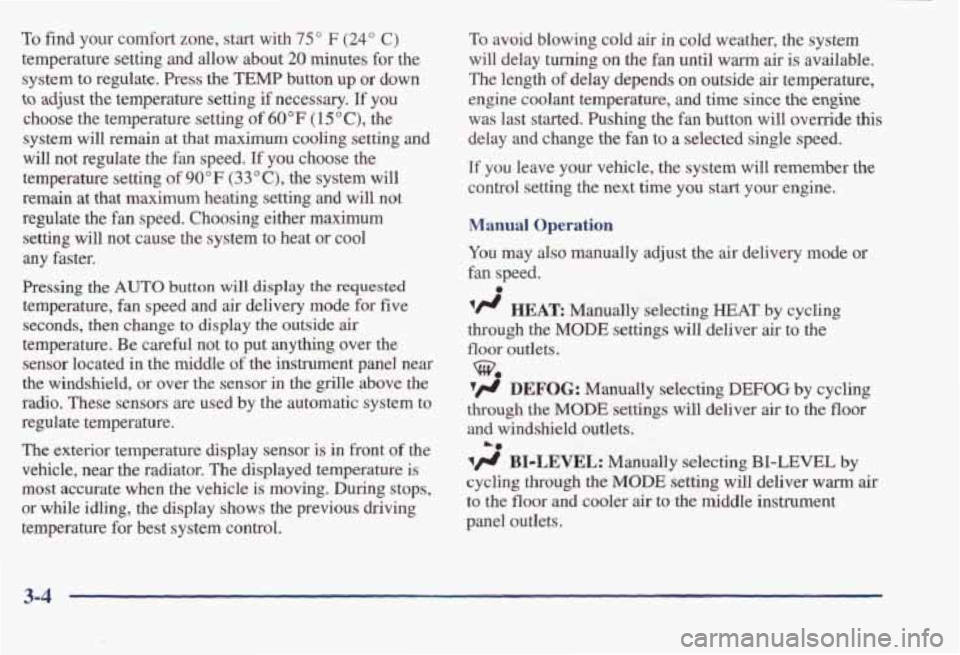
To find your comfort zone, start with 75" F (24" C)
temperature setting and allow about 20 minutes for the
system to regulate. Press the
TEMP button up or down
to adjust the temperature setting if necessary, If you
choose the temperature setting of
60°F (15 "C), the
system will remain
at that maximum cooling setting and
will not regulate the
fan speed. If you choose the
temperature setting
of 90°F (33"c), the system will
remain at that maximum heating setting and will not
regulate the fan speed. Choosing either maximum
setting will not cause the system to heat
or cool
any faster.
Pressing
the AUTO button will display the requested
temperature, fan speed and air delivery mode for five
seconds, then change
to display the outside air
temperature. Be careful not to put
anythmg over the
sensor located
in the middle of the instrument panel near
the windshield,
or over the sensor in the grille above the
radio. These sensors are used by the automatic system to
regulate temperature.
The exterior temperature display sensor is in front of the
vehicle, near the radiator. The displayed temperature is
most accurate when the vehicle is moving. During stops,
or while idling, the display shows the previous driving
temperature for best system control.
To avoid blowing cold air in cold weather, the system
will delay
turning on the fan until warm air is available.
The length of delay depends on outside
air temperature,
engine coolant temperature, and time since
the engine
was last started. Pushing the fan button will override this
delay and change the fan to a selected single speed.
If you leave your vehicle, the system will remember the
control setting
the next time you start your engine.
Manual Operation
You may also manually adjust the air delivery mode or
fan speed.
'/J HEAR Manually selecting HEAT by cycling
through
the MODE settings will deliver air to the
floor outlets.
3 DEFOG: Manually selecting DEFOG by cycling
through the
MODE settings will deliver air to the floor
and windshield outlets.
a
Lo
BIDLEVEL: Manually selecting BI-LEVEL by
cycling through the MODE setting will deliver warm air
to the floor and cooler air to the middle instrument
panel outlets.
3-4
Page 176 of 395
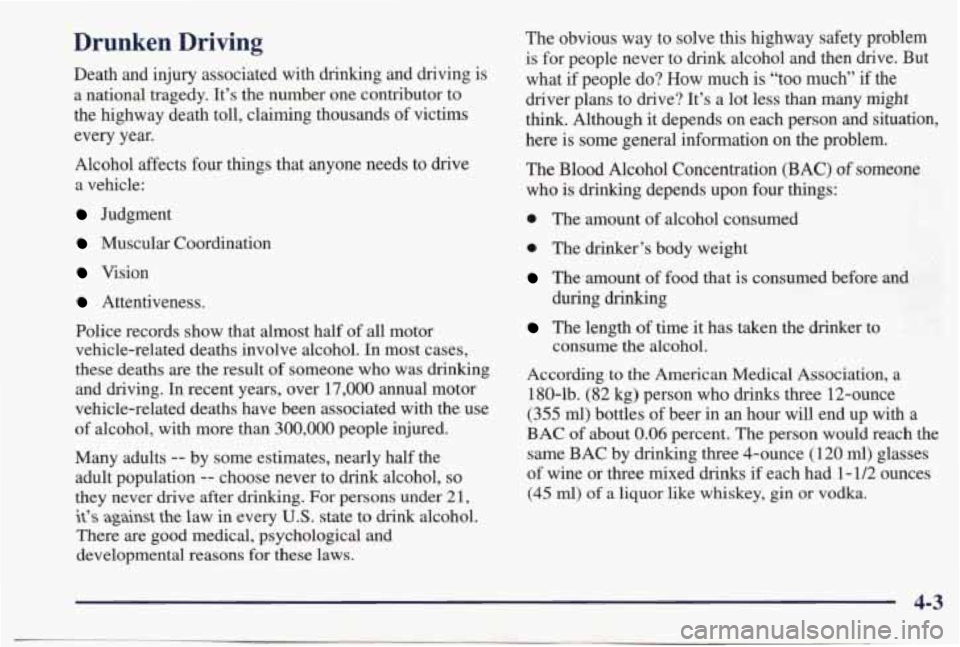
Drunken Driving
Death and injury associated with drinking and driving is
a national tragedy. It’s the number one contributor to
the highway death toll, claiming thousands of victims
every year.
Alcohol affects four things that anyone needs to drive a vehicle:
Judgment
Muscular Coordination
Vision
Attentiveness.
Police records show that almost half of
all motor
vehicle-related deaths involve alcohol. In most cases,
these deaths are the result
of someone who was drinking
and driving.
In recent years, over 17,000 annual motor
vehicle-related deaths have been associated with the use
of alcohol, with more than
300,000 people injured.
Many adults
-- by some estimates, nearly half the
adult population
-- choose never to drink alcohol, so
they never drive after drinking. For persons under 21,
it’s against the law in every U.S. state to drink alcohol.
There are good medical, psychological and
developmental reasons for these laws. The
obvious way to solve
this highway safety problem
is for people never to drink alcohol and then drive. But
what if people
do? How much is “too much” if the
driver plans to drive? It’s a lot less than many
might
think. Although it depends on each person and situation,
here is some general information on the problem.
The Blood Alcohol Concentration
(BAC) of someone
who is drinking depends upon four things:
0 The amount of alcohol consumed
0 The drinker’s body weight
The amount of food that is consumed before and
during drinking
The length of time it has taken the drinker to
consume
the alcohol.
According to
the American Medical Association, a
180-lb. (82 kg) person who drinks three 12-ounce
(355 ml) bottles of beer in an hour will end up with a
BAC of about
0.06 percent. The person would reach the
same BAC by drinking
three 4-ounce (120 ml) glasses
of wine or three mixed drinks
if each had 1 - 1/2 ounces
(45 ml) of a liquor like whiskey, gin or vodka.
4-3
Page 292 of 395
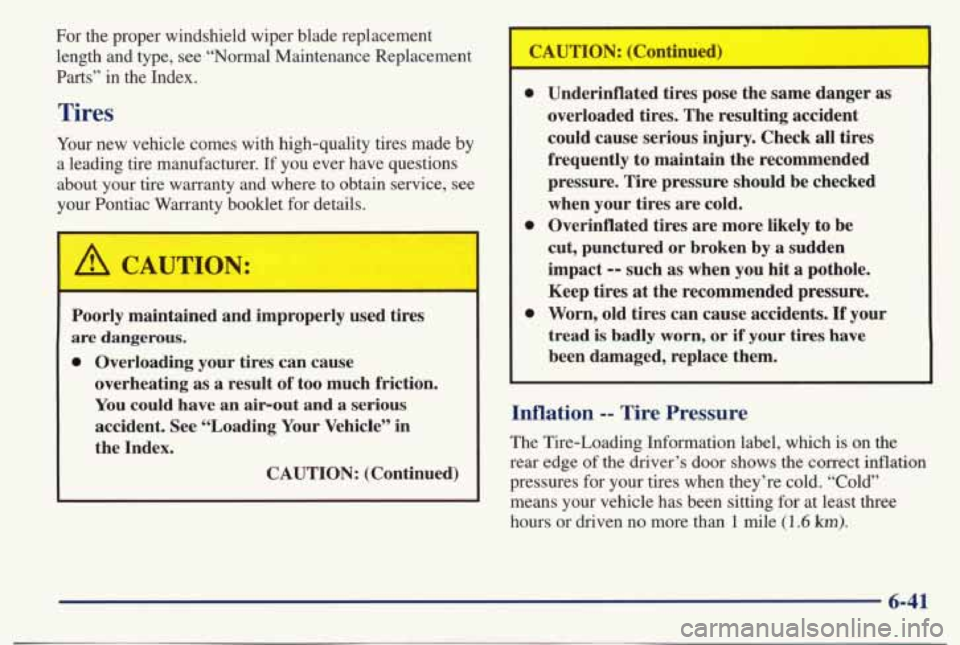
For the proper windshield wiper blade replacement length and type, see “Normal Maintenance Replacement
Parts” in the Index.
Tires
Your new vehicle comes with high-quality tires made by
a leading tire manufacturer. If you ever have questions
about your tire warranty and where to obtain service, see
your Pontiac Warranty booklet for details.
Poorly maintained and improperly used tires
are dangerous.
0 Overloading your tires can cause
overheating as a result of too much friction.
You could have an airout and a serious
accident. See “Loading Your Vehicle” in
the Index.
CAUTION: (Continued)
0
a
0
Underinflated tires pose the same danger as
overloaded tires. The resulting accident
could cause serious injury. Check
all tires
frequently to maintain the recommended
pressure. Tire pressure should be checked when your tires are cold.
Overinflated tires are more likely to be
cut, punctured or broken
by a sudden
impact
-- such as when you hit a pothole.
Keep tires
at the recommended pressure.
Worn, old tires can cause accidents.
If your
tread
is badly worn, or if your tires have
been damaged, replace them.
Inflation -- Tire Pressure
The Tire-Loading Information label, which is on the
rear edge
of the driver’s door shows the correct inflation
pressures for your tires when they’re cold. “Cold”
means your vehicle has been sitting for at least three
hours or driven no more than
1 mile (1.6 km).
6-41
Page 317 of 395
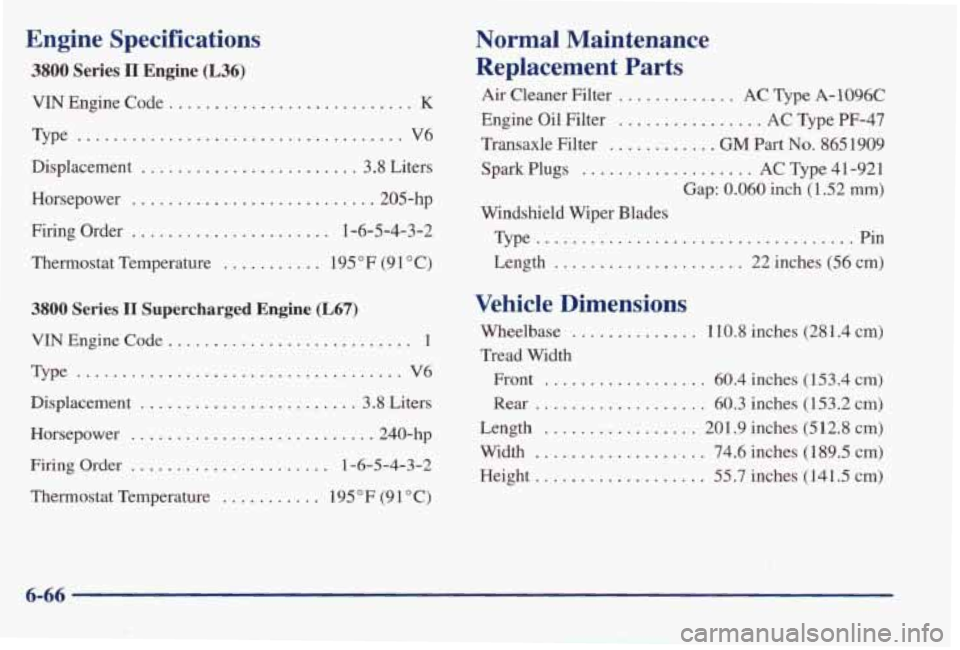
Engine Specifications
VIN Engine Code . . ................... K
Type ............ ~ ................ V6
Displacement
.................... 3.8 Liters
Horsepower
...................... .205-hp
Firing Order
...................... 1-6-5-4-3-2
3800 Series I1 Engine (L36)
Thermostat Temperature ........... 195°F (91°C)
Normal Maintenance
Replacement
Parts
Engine Oil Filter ................ AC Type PF-47
Transaxle Filter
............ GM Part No. 865 1909
Spark Plugs
................. AC Type 41-921
Air Cleaner Filter
............. AC Type A-1096C
Gap: 0.060 inch (1.52 mm)
Windshield Wiper Blades
npe
.................
Length .................
.............. Pin
. . 22 inches (56 cm)
3800 Series I1 Supercharged Engine (L67) Vehicle Dimensions
VIN Engine Code 1 .............. Wheelbase 110.8 inches (28 1.4 cm)
Tread Width ...........................
5pe .............. .................. V6
Front ........... . . 60.4 inches (153.4 cm)
Displacement
........................ 3.8 Liters
Horsepower
........................ .240-hp
Thermostat Temperature
........... 195°F (91°C)
Firing Order ...................... 1-6-5-4-3-2 Rear
................... 60.3 inches (1 53.2 cm)
Length
................. 201.9 inches (512.8 cm)
Width
................... 74.6 inches (189.5 cm)
Height
................... 55.7 inches (141.5 cm)
6-66
Page 392 of 395
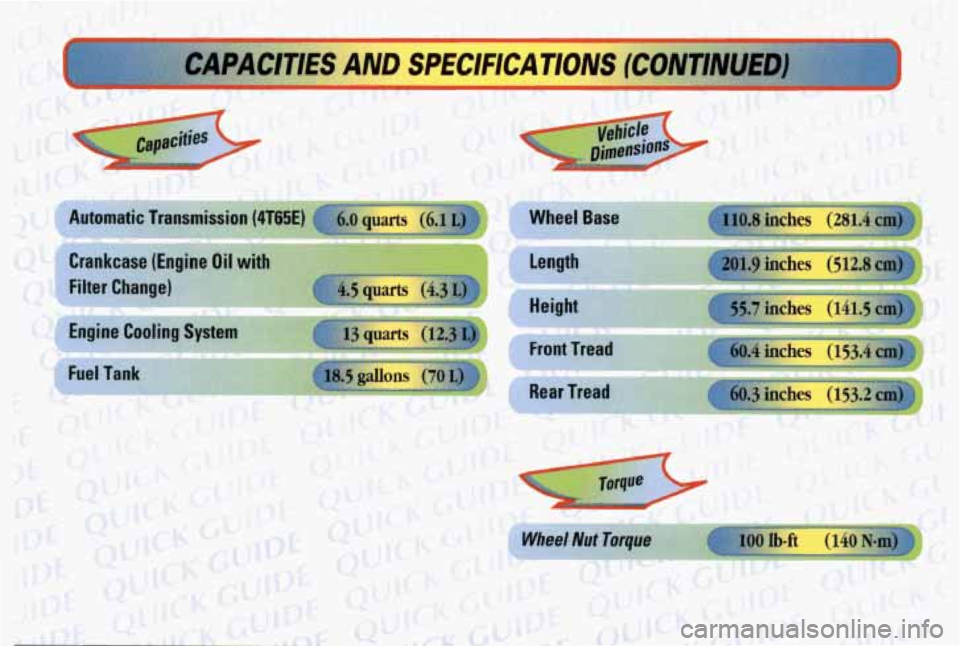
1 CAPACITIES AND SPECIFICATIONS (CONTINUEL)
I
Automatic Transmission (4165EI
t
Crankcase (Engine Oil with
Filter Change)
m
tr ne Cooling System ;,@ ,. , ..
Fuel Tank
Wheel Base
length
wont Treaa
1es (153.4 cfl:
Rear Tread 1es (153.2 CIT